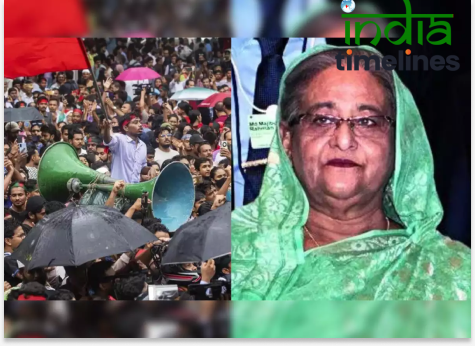
Sheikh Hasina, a name synonymous with resilience and leadership in Bangladesh, faced one of the most tumultuous periods of her life when she was forced to flee her homeland. This article delves into the series of events that unfolded at her home before she made the difficult decision to leave Bangladesh, examining the political turmoil, the personal struggles, and the extraordinary circumstances that led to her departure.
The Context Leading to Sheikh Hasina’s Departure
The late 1970s and early 1980s were marked by significant political unrest in Bangladesh. The country was still grappling with the aftermath of its independence war, and the political environment was highly unstable. Sheikh Hasina, the daughter of Sheikh Mujibur Rahman, the founding father of Bangladesh, was seen as a beacon of hope for the nation. However, her political rise was met with fierce opposition from military regimes and political rivals, who viewed her as a threat to their power.
Sheikh Hasina’s Early Life and Political Ascent
Family Background and Legacy
Born into a family deeply rooted in the struggle for Bangladesh’s independence, Sheikh Hasina was destined to play a crucial role in the nation’s political landscape. Her father, Sheikh Mujibur Rahman, led the country to independence in 1971, only to be tragically assassinated in 1975 along with most of his family members. Hasina, who was abroad at the time, became the torchbearer of her father’s legacy, vowing to continue his mission for a democratic Bangladesh.
Entry into Politics and Early Challenges
Returning to Bangladesh in 1981, Sheikh Hasina took over the leadership of the Awami League, her father’s political party. She faced numerous challenges, including navigating a political landscape dominated by military rulers and surviving assassination attempts orchestrated by those who feared her growing influence.
Becoming Prime Minister: First Term
In 1996, after years of political struggle and perseverance, Sheikh Hasina became the Prime Minister of Bangladesh for the first time. Her tenure was marked by efforts to stabilize the economy and promote democracy, but it was also marred by political opposition and unrest.
Political Challenges and Threats
Struggle for Democracy
Sheikh Hasina’s tenure was defined by her relentless pursuit of democracy in a country often dominated by military influence. She fought tirelessly against authoritarian regimes, advocating for free and fair elections and the establishment of democratic institutions.
Assassination Attempts and Security Concerns
Throughout her political career, Sheikh Hasina faced numerous assassination attempts, reflecting the dangerous and volatile political environment in Bangladesh. The most notable attempt occurred in 2004 when a grenade attack at a rally she was addressing killed several of her supporters and left her narrowly escaping death.
The Role of External Forces
In addition to internal threats, Sheikh Hasina also had to navigate complex relationships with foreign powers, some of whom had vested interests in Bangladesh’s political instability. These external forces often played a significant role in the country’s political dynamics, influencing events behind the scenes.
The Night Before Departure
Tensions Inside the Residence
As the political situation in Bangladesh deteriorated, the atmosphere inside Sheikh Hasina’s residence grew increasingly tense. Close aides and family members gathered, aware that the situation was becoming untenable. The looming threat of arrest or worse weighed heavily on everyone.
Communication with Loyalists
Despite the danger, Sheikh Hasina remained in contact with her loyalists, coordinating efforts to ensure the survival of her political movement. These communications were conducted in utmost secrecy, as any leak could have jeopardized their plans.
Final Preparations for Leaving
The decision to flee was not made lightly. As the night progressed, final arrangements were made for Sheikh Hasina’s departure. Trusted allies were tasked with ensuring her safe passage out of the country, and last-minute discussions focused on the logistics of her escape.
Escape from Bangladesh
The Decision to Flee
Faced with mounting threats and the possibility of imprisonment, Sheikh Hasina decided that fleeing the country was the only viable option. This decision was influenced by her desire to continue the fight for democracy from abroad, where she would be free from immediate danger.
Assistance from Allies
Sheikh Hasina’s escape was facilitated by a network of allies who understood the gravity of the situation. These individuals risked their own safety to ensure that she could leave Bangladesh undetected.
Safe Passage and Immediate Aftermath
Once out of the country, Sheikh Hasina sought refuge in India, where she would remain in exile for several years. The immediate aftermath of her departure saw a crackdown on her supporters in Bangladesh, but it also galvanized the Awami League, which continued to advocate for her return.
Life in Exile
Challenges Faced Abroad
Living in exile posed its own set of challenges for Sheikh Hasina. She was cut off from her political base, and the physical distance from Bangladesh made it difficult to influence events on the ground. Additionally, the uncertainty of her situation weighed heavily on her.
Maintaining Political Influence from Afar
Despite these challenges, Sheikh Hasina managed to maintain her political influence from abroad. She stayed in constant communication with her party members and continued to speak out against the military regime in Bangladesh. Her resilience and determination kept her political movement alive during her time in exile.
Planning the Return to Bangladesh
Throughout her years in exile, Sheikh Hasina never wavered in her commitment to return to Bangladesh. She and her team carefully planned her return, waiting for the right moment to re-enter the country and reclaim her position as a leader of the people.
The Return and Political Resurrection
Re-Entry into Bangladesh
In 2007, after nearly a decade in exile, Sheikh Hasina made a triumphant return to Bangladesh. Her return was met with widespread support from the public, who saw her as a symbol of hope and democracy.
Winning Back Power
Sheikh Hasina’s return marked the beginning of a new chapter in her political career. In the 2008 general elections, her party won a landslide victory, and she was once again elected Prime Minister. This victory was a testament to her resilience and the enduring support of the Bangladeshi people.
Legacy and Impact on Modern Bangladesh
Sheikh Hasina’s leadership has had a profound impact on modern Bangladesh. Her efforts to promote economic development, improve infrastructure, and strengthen democratic institutions have shaped the country’s trajectory. Today, she remains one of the most influential figures in Bangladeshi politics.
The Impact of Her Departure on Bangladesh
Short-Term Political Fallout
Sheikh Hasina’s departure left a significant void in Bangladesh’s political landscape. The immediate aftermath saw increased repression of her supporters and a consolidation of power by the military regime. However, her departure also served as a rallying point for the opposition, who continued to fight for her return.
Long-Term Implications for Democracy
In the long term, Sheikh Hasina’s departure and subsequent return have had lasting implications for democracy in Bangladesh. Her experience in exile highlighted the challenges faced by democratic leaders in the face of authoritarianism, and her eventual triumph served as a reminder of the power of resilience and determination in the fight for democracy.
Conclusion
Sheikh Hasina’s flight from Bangladesh was a pivotal moment in the country’s history. It was a period marked by danger, uncertainty, and political turmoil. However, it also demonstrated her unwavering commitment to the people of Bangladesh and her determination to continue the fight for democracy, even in the face of overwhelming odds. Her story is a testament to the resilience of the human spirit and the enduring power of hope.
FAQs
What were the main reasons behind Sheikh Hasina’s decision to flee Bangladesh?
Sheikh Hasina fled Bangladesh due to escalating threats from political rivals and the military regime, which posed a serious risk to her life and freedom.
How did Sheikh Hasina manage to maintain her political influence while in exile?
Sheikh Hasina maintained her political influence through constant communication with her party members, strategic planning, and by staying active in the international political arena.
What was the reaction of the international community to Sheikh Hasina’s departure?
The international community was largely supportive of Sheikh Hasina, viewing her as a legitimate leader who was forced into exile due to political persecution.
How did Sheikh Hasina’s return to Bangladesh shape the country’s future?
Her return marked a turning point for Bangladesh, leading to the restoration of democracy and significant political and economic reforms under her leadership.
What are the key lessons learned from Sheikh Hasina’s flight from Bangladesh?
The key lessons include the importance of resilience in the face of adversity, the role of strategic planning in political movements, and the enduring power of democratic ideals.


































